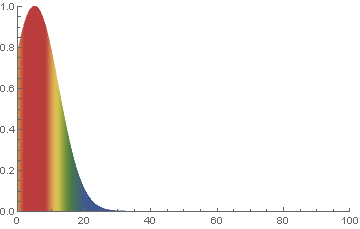|
Burgers Equation
Burgers' equation or Bateman–Burgers equation is a fundamental partial differential equation and convection–diffusion equation occurring in various areas of applied mathematics, such as fluid mechanics, nonlinear acoustics, gas dynamics, and traffic flow. The equation was first introduced by Harry Bateman in 1915 and later studied by Johannes Martinus Burgers in 1948. For a given field u(x,t) and diffusion coefficient (or ''kinematic viscosity'', as in the original fluid mechanical context) \nu, the general form of Burgers' equation (also known as viscous Burgers' equation) in one space dimension is the dissipative system: :\frac + u \frac = \nu\frac. The term u\partial u/\partial x can also be rewritten as \partial(u^2/2)/\partial x. When the diffusion term is absent (i.e. \nu=0), Burgers' equation becomes the inviscid Burgers' equation: :\frac + u \frac = 0, which is a prototype for conservation law, conservation equations that can develop discontinuities (shock waves). ... [...More Info...] [...Related Items...] OR: [Wikipedia] [Google] [Baidu] |
Shock Wave
In physics, a shock wave (also spelled shockwave), or shock, is a type of propagating disturbance that moves faster than the local speed of sound in the medium. Like an ordinary wave, a shock wave carries energy and can propagate through a medium, but is characterized by an abrupt, nearly discontinuous, change in pressure, temperature, and density of the medium. For the purpose of comparison, in supersonic speed, supersonic flows, additional increased expansion may be achieved through an expansion fan, also known as a Prandtl–Meyer expansion fan. The accompanying expansion wave may approach and eventually collide and recombine with the shock wave, creating a process of destructive interference. The sonic boom associated with the passage of a supersonic aircraft is a type of sound wave produced by Wave interference, constructive interference. Unlike solitons (another kind of nonlinear wave), the energy and speed of a shock wave alone dissipates relatively quickly with distan ... [...More Info...] [...Related Items...] OR: [Wikipedia] [Google] [Baidu] |
Rarefaction
Rarefaction is the reduction of an item's density, the opposite of compression. Like compression, which can travel in waves (sound waves, for instance), rarefaction waves also exist in nature. A common rarefaction wave is the area of low relative pressure following a shock wave (see picture). Rarefaction waves expand with time (much like sea waves spread out as they reach a beach); in most cases rarefaction waves keep the same overall profile ('shape') at all times throughout the wave's movement: it is a ''self-similar expansion''. Each part of the wave travels at the local speed of sound, in the local medium. This expansion behaviour contrasts with that of pressure increases, which gets narrower with time until they steepen into shock waves. Physical examples A natural example of rarefaction occurs in the layers of Earth's atmosphere. Because the atmosphere has mass, most atmospheric matter is nearer to the Earth due to the Earth's gravitation In physics, gravity ( ... [...More Info...] [...Related Items...] OR: [Wikipedia] [Google] [Baidu] |
N-wave
A sonic boom is a sound associated with shock waves created when an object travels through the air faster than the speed of sound. Sonic booms generate enormous amounts of sound energy, sounding similar to an explosion or a thunderclap to the human ear. The crack of a supersonic bullet passing overhead or the crack of a bullwhip are examples of a small sonic boom. Sonic booms due to large supersonic aircraft can be particularly loud and startling, tend to awaken people, and may cause minor damage to some structures. This led to the prohibition of routine supersonic flight overland. Although sonic booms cannot be completely prevented, research suggests that with careful shaping of the vehicle, the nuisance due to sonic booms may be reduced to the point that overland supersonic flight may become a feasible option. A sonic boom does not occur only at the moment an object crosses the sound barrier and neither is it heard in all directions emanating from the supersonic objec ... [...More Info...] [...Related Items...] OR: [Wikipedia] [Google] [Baidu] |
Reynolds Number
In fluid dynamics, the Reynolds number () is a dimensionless quantity that helps predict fluid flow patterns in different situations by measuring the ratio between Inertia, inertial and viscous forces. At low Reynolds numbers, flows tend to be dominated by laminar flow, laminar (sheet-like) flow, while at high Reynolds numbers, flows tend to be turbulence, turbulent. The turbulence results from differences in the fluid's speed and direction, which may sometimes intersect or even move counter to the overall direction of the flow (Eddy (fluid dynamics), eddy currents). These eddy currents begin to churn the flow, using up energy in the process, which for liquids increases the chances of cavitation. The Reynolds number has wide applications, ranging from liquid flow in a pipe to the passage of air over an aircraft wing. It is used to predict the transition from laminar–turbulent transition, laminar to turbulent flow and is used in the scaling of similar but different-sized fl ... [...More Info...] [...Related Items...] OR: [Wikipedia] [Google] [Baidu] |
Weak Shock Waves
Weak may refer to: Songs * "Weak" (AJR song), 2016 * "Weak" (Melanie C song), 2011 * "Weak" (SWV song), 1993 * "Weak" (Skunk Anansie song), 1995 * "Weak", a song by Seether from '' Seether: 2002-2013'' Television episodes * "Weak" (''Fear the Walking Dead'') * "Weak" (''Law & Order: Special Victims Unit'') See also * * * Stephen Uroš V of Serbia (1336–1371), also known as Stefan Uroš the Weak, King of Serbia and Emperor of the Serb and Greeks * Kenyan Weaks (born 1977), American retired basketball player * Weakness (other) * Week A week is a unit of time equal to seven days. It is the standard time period used for short cycles of days in most parts of the world. The days are often used to indicate common work days and rest days, as well as days of worship. Weeks are ofte ... {{disambiguation ... [...More Info...] [...Related Items...] OR: [Wikipedia] [Google] [Baidu] |
Solving The Heat Equation Using Fourier Series
In mathematics and physics (more specifically thermodynamics), the heat equation is a parabolic partial differential equation. The theory of the heat equation was first developed by Joseph Fourier in 1822 for the purpose of modeling how a quantity such as heat diffuses through a given region. Since then, the heat equation and its variants have been found to be fundamental in many parts of both pure and applied mathematics. Definition Given an open subset of and a subinterval of , one says that a function is a solution of the heat equation if : \frac = \frac + \cdots + \frac, where denotes a general point of the domain. It is typical to refer to as time and as spatial variables, even in abstract contexts where these phrases fail to have their intuitive meaning. The collection of spatial variables is often referred to simply as . For any given value of , the right-hand side of the equation is the Laplacian of the function . As such, the heat equation is often written mor ... [...More Info...] [...Related Items...] OR: [Wikipedia] [Google] [Baidu] |
Heat Equation
In mathematics and physics (more specifically thermodynamics), the heat equation is a parabolic partial differential equation. The theory of the heat equation was first developed by Joseph Fourier in 1822 for the purpose of modeling how a quantity such as heat diffuses through a given region. Since then, the heat equation and its variants have been found to be fundamental in many parts of both pure and applied mathematics. Definition Given an open subset of and a subinterval of , one says that a function is a solution of the heat equation if : \frac = \frac + \cdots + \frac, where denotes a general point of the domain. It is typical to refer to as time and as spatial variables, even in abstract contexts where these phrases fail to have their intuitive meaning. The collection of spatial variables is often referred to simply as . For any given value of , the right-hand side of the equation is the Laplace operator, Laplacian of the function . As such, the heat equation is ... [...More Info...] [...Related Items...] OR: [Wikipedia] [Google] [Baidu] |
Cole–Hopf Transformation
The Cole–Hopf transformation is a change of variables that allows to transform a special kind of parabolic partial differential equations (PDEs) with a quadratic nonlinearity into a linear heat equation. In particular, it provides an explicit formula for fairly general solutions of the PDE in terms of the initial datum and the heat kernel. Consider the following PDE:u_ - a\Delta u + b\, \nabla u\, ^ = 0, \quad u(0,x) = g(x) where x\in \mathbb^, a,b are constants, \Delta is the Laplace operator, \nabla is the gradient, and \, \cdot\, is the Euclidean norm in \mathbb^. By assuming that w = \phi(u), where \phi(\cdot) is an unknown smooth function, we may calculate:w_ = \phi'(u)u_, \quad \Delta w = \phi'(u)\Delta u + \phi''(u)\, \nabla u\, ^ Which implies that:\begin w_ = \phi'(u)u_ &= \phi'(u)\left( a\Delta u - b\, \nabla u\, ^\right) \\ &= a\Delta w - (a\phi'' + b\phi')\, \nabla u\, ^ \\ &= a\Delta w \end if we constrain \phi to satisfy a\phi'' + b\phi' = 0. Then we may transform ... [...More Info...] [...Related Items...] OR: [Wikipedia] [Google] [Baidu] |
Subrahmanyan Chandrasekhar
Subrahmanyan Chandrasekhar (; 19 October 1910 – 21 August 1995) was an Indian Americans, Indian-American theoretical physicist who made significant contributions to the scientific knowledge about the structure of stars, stellar evolution and black holes. He was awarded the 1983 Nobel Prize in Physics along with William Alfred Fowler, William A. Fowler for theoretical studies of the physical processes of importance to the structure and evolution of the stars. His mathematical treatment of stellar evolution yielded many of the current theoretical models of the later evolutionary stages of massive stars and black holes. Many concepts, institutions and inventions, including the Chandrasekhar limit and the Chandra X-ray Observatory, Chandra X-Ray Observatory, are named after him. Chandrasekhar worked on a wide variety of problems in physics during his lifetime, contributing to the contemporary understanding of stellar structure, white dwarfs, stellar dynamics, stochastic process, r ... [...More Info...] [...Related Items...] OR: [Wikipedia] [Google] [Baidu] |
First-order Partial Differential Equation
In mathematics, a first-order partial differential equation is a partial differential equation that involves the first derivatives of an unknown function u of n\geq 2 variables. The equation takes the form F(x_1,\ldots,x_n,u,u_,\ldots u_) =0, using subscript notation to denote the partial derivatives of u. Such equations arise in the construction of characteristic surfaces for hyperbolic partial differential equations, in the calculus of variations, in some geometrical problems, and in simple models for gas dynamics whose solution involves the method of characteristics, e.g., the advection equation. If a family of solutions of a single first-order partial differential equation can be found, then additional solutions may be obtained by forming envelopes of solutions in that family. In a related procedure, general solutions may be obtained by integrating families of ordinary differential equations. General solution and complete integral The ''general solution'' to the first order ... [...More Info...] [...Related Items...] OR: [Wikipedia] [Google] [Baidu] |





